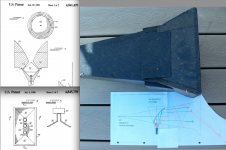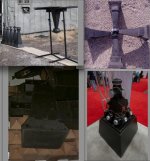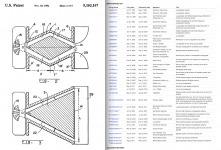Hey badman,
just wondering how do you know that the differences that you are hearing are the *actual* differences that are occurring? no doubt, it does sound different, maybe even better. but, I'll give you odds that the effects are about nil at the LF end...
_-_-
I played around with it with pink noise and a mic. Enough to see that the off-axis consistency at the low end was improved, it was readily apparent- lots of variance at the edge of the pattern at and below horn cutoff without, much less, with. If you'd like to give me odds, I'm good with that- how about a quad of the PiSpeakers waveguide against a pair of them (or something equally valuable, around $90)? My testing methods are rough but sufficient to do all but the most refined tweaking. They're combined with modeling and the end result is that I can validate when something's acting (largely) as I want. If I weren't such a slacker I'd get serious and do a "real" measurement rig....
Of course, we might be better served to let a third party examine the effect. It's similar to a big mouth roundover, but without the support/reinforcement below cutoff. Remember that the "low end" is around and above 1khz with this device. The absorbtion coefficients of open cell foam are quite high in this range, and really crush the interference pattern from the edge.
I'm confused: why wouldn't the directivity match between woofer and tweeter in a concentric driver (using "concentric" rather than "coaxial" to distinguish drivers that use the woofer cone as the waveguide from drivers with horns protruding from the woofer cone) only work at fairly high crossovers?
For example, Tannoy's 12" midfield monitor from the mid-1990s, the System 12 DMT II, crosses at ~1.4kHz and with a fairly low order slope. True, based on your comments I suspect that is a higher crossover point than you use with your comparably-sized Abbey. But not that much higher. Also, having had the 12" Dual and the B&C woofer next to each other, the cone of the Tannoy is a bit larger, mostly due to the thinner surround. So that strikes me more as "not having" those problems than "working around them." Admittedly, as to the quality of the polars I'm asserting without data. I need to build a decent turntable and fix that!
Those measurements are from desktop monitor designed around a current-production KEF concentric driver. The driver has an 8" woofer, with a 1.5" tweeter firing into a radial ("Tangerine" is the marketing name) phase plug. The crossover is fairly steep and asymmetric, with a nominal crossover point of 2kHz.
Is there something I'm missing in the directivity match there?
No, I think that you have it right. I was thinking more along the lines of the smaller "coaxial" (10") driver that I have played with. The horns are very small and the directivity of a 10" is pretty wide at 1-2 kHz. But in your examples its obvious that this can be made to work. Thanks for showing those.
Its good to see someone show polar maps that look like what I get. All I see around here are the heavily smoothed ones that obscure everything that you are trying to look at. Polar maps are the very best source of data that I know of, but only if they are not heavily smoothed (and axial normalized.)
Tom,Hi Art
Actually working with conical horns began somewhat before then, first with acoustic levitation sources ...And then with an array of sources trying to emulate a single source.
The Y throat was a losing proposition as it has significant interference up high.
Note the date on the patent below relative to the Vdosc patent as well.
The idea for the Unity horn prior to the Synergy horn approach was driven by the interference pattern the other systems produced because of the excessive source separation, it was clear from the work above on levitation sources, one needed to make the spacing small (less than about `1/4 wl) to avoid the problems which all of the prior art exhibited.
Best,
Tom
Actually Dave Gunness' update on the "Y throat" used in the MT4 system was not too bad for upper interference, but suffered from throat (air non-linearity) distortion, too much SPL from the multiple drivers combined in too small a throat made for hashy sound when driven much over the level a single driver could put out.
Your Acoustic Levitator looks a bit more exponential than conical in the patent, and the conical horn in the 7/4/89 does not exhibit the "Keele Break" (secondary angle) that the Maltese HF horn I showed you in '93 and your later SH horns have.
Of course, you had already read Keele's AES paper, but I like to think the Maltese Horn had at least a subliminal effect in your development of the Unity/Synergy:^).
Your Unity/Synergy development used scientific rigor, while the Maltese project was mostly manic "cowboy engineering".
It is interesting that Christian Heil's 11/10/92 much referenced patent does not show the cone drivers on the side of the HF horn, though the Vdosc cabinets had that feature.
Had you experimented with multiple drivers covering different frequency ranges on a single horn before 11/10/92 ?
Art
Attachments
***
But here's another case of a concentric driver with FR and polar data, smoothed at (I believe) 1/24 octave:

Since I can't edit my original post, I'd like to correct my error above here. The smoothing in that graph is (as it says on the picture) 1/48 octave.
That's exactly right and quite obvious. I see a debullcrap thread in my future and man is is gonna be good.
OK, but then instead of "who cares"... why not just cross over to a proper (horn, or ribbon) tweeter at around 7-8kHz, thereby reducing the output from the breaking-up compression driver? The supposed "complications" and "non-ideality" of the crossover (phase issues etc.) are no longer relevant at those frequencies, where the human hearing systems is incapable of detecting phase; OTOH, the reduced distortion should be audible.
I think when a tweeter is not added, it is mainly because of cost considerations, not because forcing the compression driver to cover all frequencies up to its extreme limit is the best approach, all things considered.
Marco
Would you mind sharing your sources?Easiest way to see the effect is in a CSD plot. Ribbons DO decay faster than domes.
Why don't wee see more horn loaded ribbons in use? Are there no ribbons (in horn loaded configuration) that can work well down to about 1000 Hz?
Hi-Vi had some pro boxes with horn loaded ribbons, IIRC. Don't think they sold in the West.
Would like to hear them.
Would like to hear them.
i personally thought horn loading my RAAL ribbons sounded better then leaving them stock.
gave them a bit more punch and tactility when crossed at 2500hz.
they didnt measure as flat on-axis though, so maybe thats why people don't do it more often 😕
gave them a bit more punch and tactility when crossed at 2500hz.
they didnt measure as flat on-axis though, so maybe thats why people don't do it more often 😕
I know horn loading was done quite a bit with the old SA 8535 ribbon. I think Pevey speakers did this and maybe still does.
Stage Accompany
Couldn't be crossed particurlary low though.
The ribbons below should work lower in frequency, but I assume there are reasons why horn loading isn't much done with these kinds of drivers.
PAP-108
Transmission Audio Inc.
Stage Accompany
Couldn't be crossed particurlary low though.
The ribbons below should work lower in frequency, but I assume there are reasons why horn loading isn't much done with these kinds of drivers.
PAP-108
Transmission Audio Inc.
There are horn loaded ribbons that can work well from a sound quality standpoint down to about 1000 Hz, but the lesser displacement of a ribbon limits the output potential compared to compression drivers of a similar diaphragm area.Why don't wee see more horn loaded ribbons in use? Are there no ribbons (in horn loaded configuration) that can work well down to about 1000 Hz?
I noticed some time ago that we have a tendency to allow "buzzherrings" get thrown in when we discuss the pros/cons/beauty/types of "distortion" of horn speakers. The overwhelming clarity of very high efficiency speakers like Klipsch Heritage etc, damn near trumps their lack of being buzzherring compliant and we also tend to throw the word "non linear" in here when it has little bearing. I find it very interesting that we tend to gag at diffraction gnats while possibly swallowing distortion locusts. I see one thing in print but what I hear in my mind is "studies show we can't hear audible distortion" (-: And yet those Khorns sound so clean compared with all of these great shallow horn directivity matched speakers. Must be my imagination. I can however hear a degradation when I pull the foam off of the Peavey horns.
Yes, great shallow horns = less driver loading at low frequency = greater diaphragm motion = more intermodulation. Hold that thought in your mind, because you can't hear distortion after you have swallowed it.
After eating enough locusts, it just seems like something is missing without them.
Do diffraction gnats with round wings sound different from diffraction gnats with rectangular wings?
After eating enough locusts, it just seems like something is missing without them.
Do diffraction gnats with round wings sound different from diffraction gnats with rectangular wings?
🙂
The diffraction occurring around the head & ears is probably greater than that found in most good acoustic horns, particularly while the observer is dinning on crunchy insects and other flying critters. WHG
Yes, great shallow horns = less driver loading at low frequency = greater diaphragm motion = more intermodulation. Hold that thought in your mind, because you can't hear distortion after you have swallowed it.
After eating enough locusts, it just seems like something is missing without them.
Do diffraction gnats with round wings sound different from diffraction gnats with rectangular wings?
The diffraction occurring around the head & ears is probably greater than that found in most good acoustic horns, particularly while the observer is dinning on crunchy insects and other flying critters. WHG
Above two posts ^ Exactly. People are eating locusts everywhere these days, and getting used to it. Less bitter diaphragm movement in the next bottle steward l think I can tolerate a the slight woody notes of diffraction. Of course neither is also possible now.
Back in the 1970's a certain Mr. Iwata in Japan came to similar conclusions.
Is that the same Mr. Iwata that makes the air brushes and paint spray guns? Because I used a borrowed Iwata basecoat gun to spray the metallic basecoat on the Hot Rod Lincoln (after screwing it up with my DeVilbiss gun that was really designed to shoot clear), and it made it pretty easy to shoot the metallic base coat. It was a $600 spray gun and I loved using it.
You do realize that to many people, unbearably harsh and ragged HF is what they sound like, right? "Clean" and "overwhelming clarity" are not a consensus perception of old Klipsch designs.The overwhelming clarity of very high efficiency speakers like Klipsch Heritage etc, damn near trumps their lack of being buzzherring compliant and we also tend to throw the word "non linear" in here when it has little bearing... ...And yet those Khorns sound so clean compared with all of these great shallow horn directivity matched speakers.
Good question. I really don't know, but suspect that Iwata is a fairly common name in Japan. Would be very interesting of it is the same man or family.Is that the same Mr. Iwata that makes the air brushes and paint spray guns?
- Status
- Not open for further replies.
- Home
- Loudspeakers
- Multi-Way
- Are Most Horns Fundamentally Flawed?



